FFT MegaCore Function User Guide
FFT MegaCore Function
User Guide
101 Innovation Drive
San Jose, CA 95134
www.altera.com
UG-FFT-11.1
Subscribe
�
© 2011 Altera Corporation. All rights reserved. ALTERA, ARRIA, CYCLONE, HARDCOPY, MAX, MEGACORE, NIOS, QUARTUS and STRATIX words and logos
are trademarks of Altera Corporation and registered in the U.S. Patent and Trademark Office and in other countries. All other words and logos identified as
trademarks or service marks are the property of their respective holders as described at www.altera.com/common/legal.html. Altera warrants performance of its
semiconductor products to current specifications in accordance with Altera's standard warranty, but reserves the right to make changes to any products and
services at any time without notice. Altera assumes no responsibility or liability arising out of the application or use of any information, product, or service
described herein except as expressly agreed to in writing by Altera. Altera customers are advised to obtain the latest version of device specifications before relying
on any published information and before placing orders for products or services.
ISO
9001:2008
Registered
November 2011 Altera Corporation
FFT MegaCore Function
User Guide
�
Contents
Chapter 1. About This MegaCore Function
Release Information . . . . . . . . . . . . . . . . . . . . . . . . . . . . . . . . . . . . . . . . . . . . . . . . . . . . . . . . . . . . . . . . . . . . . 1–1
Device Family Support . . . . . . . . . . . . . . . . . . . . . . . . . . . . . . . . . . . . . . . . . . . . . . . . . . . . . . . . . . . . . . . . . . . 1–1
Features . . . . . . . . . . . . . . . . . . . . . . . . . . . . . . . . . . . . . . . . . . . . . . . . . . . . . . . . . . . . . . . . . . . . . . . . . . . . . . . . 1–2
General Description . . . . . . . . . . . . . . . . . . . . . . . . . . . . . . . . . . . . . . . . . . . . . . . . . . . . . . . . . . . . . . . . . . . . . 1–3
Fixed Transform Size Architecture . . . . . . . . . . . . . . . . . . . . . . . . . . . . . . . . . . . . . . . . . . . . . . . . . . . . . . 1–3
Variable Streaming Architecture . . . . . . . . . . . . . . . . . . . . . . . . . . . . . . . . . . . . . . . . . . . . . . . . . . . . . . . . 1–4
MegaCore Verification . . . . . . . . . . . . . . . . . . . . . . . . . . . . . . . . . . . . . . . . . . . . . . . . . . . . . . . . . . . . . . . . . . . 1–4
Performance and Resource Utilization . . . . . . . . . . . . . . . . . . . . . . . . . . . . . . . . . . . . . . . . . . . . . . . . . . . . . . 1–4
Cyclone III Devices . . . . . . . . . . . . . . . . . . . . . . . . . . . . . . . . . . . . . . . . . . . . . . . . . . . . . . . . . . . . . . . . . . . . 1–5
Stratix III Devices . . . . . . . . . . . . . . . . . . . . . . . . . . . . . . . . . . . . . . . . . . . . . . . . . . . . . . . . . . . . . . . . . . . . . 1–8
Stratix IV Devices . . . . . . . . . . . . . . . . . . . . . . . . . . . . . . . . . . . . . . . . . . . . . . . . . . . . . . . . . . . . . . . . . . . . 1–11
Stratix V Devices . . . . . . . . . . . . . . . . . . . . . . . . . . . . . . . . . . . . . . . . . . . . . . . . . . . . . . . . . . . . . . . . . . . . . 1–14
Installation and Licensing . . . . . . . . . . . . . . . . . . . . . . . . . . . . . . . . . . . . . . . . . . . . . . . . . . . . . . . . . . . . . . . 1–18
OpenCore Plus Evaluation . . . . . . . . . . . . . . . . . . . . . . . . . . . . . . . . . . . . . . . . . . . . . . . . . . . . . . . . . . . . 1–18
OpenCore Plus Time-Out Behavior . . . . . . . . . . . . . . . . . . . . . . . . . . . . . . . . . . . . . . . . . . . . . . . . . . . . . 1–19
Chapter 2. Getting Started
Design Flows . . . . . . . . . . . . . . . . . . . . . . . . . . . . . . . . . . . . . . . . . . . . . . . . . . . . . . . . . . . . . . . . . . . . . . . . . . . 2–1
DSP Builder Flow . . . . . . . . . . . . . . . . . . . . . . . . . . . . . . . . . . . . . . . . . . . . . . . . . . . . . . . . . . . . . . . . . . . . . . . 2–1
MegaWizard Plug-In Manager Flow . . . . . . . . . . . . . . . . . . . . . . . . . . . . . . . . . . . . . . . . . . . . . . . . . . . . . . . 2–2
Parameterize the MegaCore Function . . . . . . . . . . . . . . . . . . . . . . . . . . . . . . . . . . . . . . . . . . . . . . . . . . . . 2–3
Set Up Simulation . . . . . . . . . . . . . . . . . . . . . . . . . . . . . . . . . . . . . . . . . . . . . . . . . . . . . . . . . . . . . . . . . . . . 2–10
Generate the MegaCore Function . . . . . . . . . . . . . . . . . . . . . . . . . . . . . . . . . . . . . . . . . . . . . . . . . . . . . . 2–10
Simulate the Design . . . . . . . . . . . . . . . . . . . . . . . . . . . . . . . . . . . . . . . . . . . . . . . . . . . . . . . . . . . . . . . . . . . . 2–12
Simulate in the MATLAB Software . . . . . . . . . . . . . . . . . . . . . . . . . . . . . . . . . . . . . . . . . . . . . . . . . . . . . 2–13
Fixed Transform Architectures . . . . . . . . . . . . . . . . . . . . . . . . . . . . . . . . . . . . . . . . . . . . . . . . . . . . . . 2–13
Variable Streaming Architecture . . . . . . . . . . . . . . . . . . . . . . . . . . . . . . . . . . . . . . . . . . . . . . . . . . . . . 2–14
Simulate with IP Functional Simulation Models . . . . . . . . . . . . . . . . . . . . . . . . . . . . . . . . . . . . . . . . . . 2–15
Simulating in Third-Party Simulation Tools Using NativeLink . . . . . . . . . . . . . . . . . . . . . . . . . . . . . 2–15
Compile the Design . . . . . . . . . . . . . . . . . . . . . . . . . . . . . . . . . . . . . . . . . . . . . . . . . . . . . . . . . . . . . . . . . . . . . 2–16
Fixed Transform Architecture . . . . . . . . . . . . . . . . . . . . . . . . . . . . . . . . . . . . . . . . . . . . . . . . . . . . . . . . . 2–16
Variable Streaming Architecture . . . . . . . . . . . . . . . . . . . . . . . . . . . . . . . . . . . . . . . . . . . . . . . . . . . . . . . 2–16
Program a Device . . . . . . . . . . . . . . . . . . . . . . . . . . . . . . . . . . . . . . . . . . . . . . . . . . . . . . . . . . . . . . . . . . . . . . 2–16
Chapter 3. Functional Description
Buffered, Burst, & Streaming Architectures . . . . . . . . . . . . . . . . . . . . . . . . . . . . . . . . . . . . . . . . . . . . . . . . . 3–1
Variable Streaming Architecture . . . . . . . . . . . . . . . . . . . . . . . . . . . . . . . . . . . . . . . . . . . . . . . . . . . . . . . . . . . 3–2
The Avalon Streaming Interface . . . . . . . . . . . . . . . . . . . . . . . . . . . . . . . . . . . . . . . . . . . . . . . . . . . . . . . . . . . 3–3
FFT Processor Engine Architectures . . . . . . . . . . . . . . . . . . . . . . . . . . . . . . . . . . . . . . . . . . . . . . . . . . . . . . . . 3–4
Radix-22 Single Delay Feedback Architecture . . . . . . . . . . . . . . . . . . . . . . . . . . . . . . . . . . . . . . . . . . . . . 3–4
Mixed Radix-4/2 Architecture . . . . . . . . . . . . . . . . . . . . . . . . . . . . . . . . . . . . . . . . . . . . . . . . . . . . . . . . . . 3–5
Quad-Output FFT Engine Architecture . . . . . . . . . . . . . . . . . . . . . . . . . . . . . . . . . . . . . . . . . . . . . . . . . . 3–5
Single-Output FFT Engine Architecture . . . . . . . . . . . . . . . . . . . . . . . . . . . . . . . . . . . . . . . . . . . . . . . . . . 3–6
I/O Data Flow Architectures . . . . . . . . . . . . . . . . . . . . . . . . . . . . . . . . . . . . . . . . . . . . . . . . . . . . . . . . . . . . . . 3–6
Streaming . . . . . . . . . . . . . . . . . . . . . . . . . . . . . . . . . . . . . . . . . . . . . . . . . . . . . . . . . . . . . . . . . . . . . . . . . . . . 3–7
Streaming FFT Operation . . . . . . . . . . . . . . . . . . . . . . . . . . . . . . . . . . . . . . . . . . . . . . . . . . . . . . . . . . . . 3–7
Enabling the Streaming FFT . . . . . . . . . . . . . . . . . . . . . . . . . . . . . . . . . . . . . . . . . . . . . . . . . . . . . . . . . . 3–8
November 2011 Altera Corporation
FFT MegaCore Function
User Guide
�
iv
Contents
Variable Streaming . . . . . . . . . . . . . . . . . . . . . . . . . . . . . . . . . . . . . . . . . . . . . . . . . . . . . . . . . . . . . . . . . . . . 3–8
Change the Block Size . . . . . . . . . . . . . . . . . . . . . . . . . . . . . . . . . . . . . . . . . . . . . . . . . . . . . . . . . . . . . . . 3–8
Enabling the Variable Streaming FFT . . . . . . . . . . . . . . . . . . . . . . . . . . . . . . . . . . . . . . . . . . . . . . . . . . 3–9
Dynamically Changing the FFT Size . . . . . . . . . . . . . . . . . . . . . . . . . . . . . . . . . . . . . . . . . . . . . . . . . . 3–10
The Effect of I/O Order . . . . . . . . . . . . . . . . . . . . . . . . . . . . . . . . . . . . . . . . . . . . . . . . . . . . . . . . . . . . 3–10
Buffered Burst . . . . . . . . . . . . . . . . . . . . . . . . . . . . . . . . . . . . . . . . . . . . . . . . . . . . . . . . . . . . . . . . . . . . . . . 3–11
Burst . . . . . . . . . . . . . . . . . . . . . . . . . . . . . . . . . . . . . . . . . . . . . . . . . . . . . . . . . . . . . . . . . . . . . . . . . . . . . . . 3–13
Parameters . . . . . . . . . . . . . . . . . . . . . . . . . . . . . . . . . . . . . . . . . . . . . . . . . . . . . . . . . . . . . . . . . . . . . . . . . . . . 3–14
Signals . . . . . . . . . . . . . . . . . . . . . . . . . . . . . . . . . . . . . . . . . . . . . . . . . . . . . . . . . . . . . . . . . . . . . . . . . . . . . . . . 3–16
Appendix 4. Block Floating Point Scaling
Introduction . . . . . . . . . . . . . . . . . . . . . . . . . . . . . . . . . . . . . . . . . . . . . . . . . . . . . . . . . . . . . . . . . . . . . . . . . . . . 4–1
Block Floating Point . . . . . . . . . . . . . . . . . . . . . . . . . . . . . . . . . . . . . . . . . . . . . . . . . . . . . . . . . . . . . . . . . . . . . 4–1
Calculating Possible Exponent Values . . . . . . . . . . . . . . . . . . . . . . . . . . . . . . . . . . . . . . . . . . . . . . . . . . . . . . 4–2
Implementing Scaling . . . . . . . . . . . . . . . . . . . . . . . . . . . . . . . . . . . . . . . . . . . . . . . . . . . . . . . . . . . . . . . . . . . . 4–2
Achieving Unity Gain in an IFFT+FFT Pair . . . . . . . . . . . . . . . . . . . . . . . . . . . . . . . . . . . . . . . . . . . . . . . . . 4–4
Additional Information
Revision History . . . . . . . . . . . . . . . . . . . . . . . . . . . . . . . . . . . . . . . . . . . . . . . . . . . . . . . . . . . . . . . . . . . . . Info–1
How to Contact Altera . . . . . . . . . . . . . . . . . . . . . . . . . . . . . . . . . . . . . . . . . . . . . . . . . . . . . . . . . . . . . . . . Info–2
Typographic Conventions . . . . . . . . . . . . . . . . . . . . . . . . . . . . . . . . . . . . . . . . . . . . . . . . . . . . . . . . . . . . . Info–2
FFT MegaCore Function
User Guide
November 2011 Altera Corporation
�
1. About This MegaCore Function
Release Information
Table 1–1 lists information about this release of the Altera® FFT MegaCore® function.
Table 1–1. FFT MegaCore Function Release Information
Item
Version
Release Date
Ordering Code
Product ID
Vendor ID
Description
11.1
November 2011
IP-FFT
0034
6AF7
f For more information about this release, refer to the MegaCore IP Library Release Notes
and Errata.
Altera verifies that the current version of the Quartus® II software compiles the
previous version of each MegaCore® function. The MegaCore IP Library Release Notes
and Errata report any exceptions to this verification. Altera does not verify
compilation with MegaCore function versions older than one release.
Device Family Support
Table 1–2 lists the device support levels for Altera IP cores.
Table 1–2. Altera IP Core Device Support Levels
FPGA Device Families
HardCopy Device Families
Preliminary support—The IP core is verified with
preliminary timing models for this device family. The IP core
meets all functional requirements, but might still be
undergoing timing analysis for the device family. It can be
used in production designs with caution.
Final support—The IP core is verified with final timing
models for this device family. The IP core meets all
functional and timing requirements for the device family and
can be used in production designs.
HardCopy Companion—The IP core is verified with
preliminary timing models for the HardCopy companion
device. The IP core meets all functional requirements, but
might still be undergoing timing analysis for the HardCopy
device family. It can be used in production designs with
caution.
HardCopy Compilation—The IP core is verified with final
timing models for the HardCopy device family. The IP core
meets all functional and timing requirements for the device
family and can be used in production designs.
November 2011 Altera Corporation
FFT MegaCore Function
User Guide
�
1–2
Chapter 1: About This MegaCore Function
Features
Table 1–3 lists the level of support offered by the FFT MegaCore function to each of
the Altera device families.
Table 1–3. Device Family Support
Device Family
Arria® GX
Arria II GX
Arria II GZ
Arria V
Cyclone®
Cyclone II
Cyclone III
Cyclone III LS
Cyclone IV
Cyclone V
HardCopy® II
HardCopy III
HardCopy IV E
HardCopy IV GX
Stratix®
Stratix II
Stratix II GX
Stratix III
Stratix IV GT
Stratix IV GX/E
Stratix V
Stratix GX
Support
Final
Final
Final
Refer to the What’s New in Altera IP page of the Altera
website.
Final
Final
Final
Final
Final
Refer to the What’s New in Altera IP page of the Altera
website.
HardCopy Compilation
HardCopy Compilation
HardCopy Compilation
HardCopy Compilation
Final
Final
Final
Final
Final
Final
Preliminary
Final
Features
The following lists the features of the FFT MegaCore function:
■ Bit-accurate MATLAB models
■ Enhanced variable streaming FFT:
■ Single precision floating point or fixed point representation
■
Input and output orders include natural order, bit reversed or digit-reversed,
and DC-centered (–N/2 to N/2)
■ Reduced memory requirements
■ Support for 8 to 32-bit data and twiddle width
■ Radix-4, mixed radix-4/2 implementations (for floating point FFT), and radix-22
single delay feedback implementation (for fixed point FFT)
FFT MegaCore Function
User Guide
November 2011 Altera Corporation
�
Chapter 1: About This MegaCore Function
General Description
1–3
■ Block floating-point architecture—maintains the maximum dynamic range of data
during processing (not for variable streaming)
■ Uses embedded memory
■ Maximum system clock frequency more than 300 MHz
■ Optimized to use Stratix series DSP blocks and TriMatrix™ memory
architecture
■ High throughput quad-output radix 4 FFT engine
■ Support for multiple single-output and quad-output engines in parallel
■ Multiple I/O data flow modes: streaming, buffered burst, and burst
■ User control over optimization in DSP blocks or in speed in Stratix V devices, for
streaming, buffered burst, and burst modes and for variable streaming fixed point
mode
■ Avalon® Streaming (Avalon-ST) compliant input and output interfaces
■ Parameterization-specific VHDL and Verilog HDL testbench generation
■ Transform direction (FFT/IFFT) specifiable on a per-block basis
■ Easy-to-use IP Toolbench interface
■ IP functional simulation models for use in Altera-supported VHDL and Verilog
HDL simulators
■ DSP Builder ready
f For more information about Avalon-ST interfaces, refer to the Avalon Interface
Specifications.
General Description
The FFT MegaCore function is a high performance, highly-parameterizable Fast
Fourier transform (FFT) processor. The FFT MegaCore function implements a
complex FFT or inverse FFT (IFFT) for high-performance applications.
The FFT MegaCore function implements the following architectures:
■ Fixed transform size architecture
■ Variable streaming architecture
Fixed Transform Size Architecture
The fixed transform architecture FFT implements a radix-2/4 decimation-in-
frequency (DIF) FFT fixed-transform size algorithm for transform lengths of 2m where
6 m 16. This architecture uses block-floating point representations to achieve the
best trade-off between maximum signal-to-noise ratio (SNR) and minimum size
requirements.
November 2011 Altera Corporation
FFT MegaCore Function
User Guide
�
1–4
Chapter 1: About This MegaCore Function
MegaCore Verification
The fixed transform architecture accepts as an input a two’s complement format
complex data vector of length N, where N is the desired transform length in natural
order; the function outputs the transform-domain complex vector in natural order. An
accumulated block exponent is output to indicate any data scaling that has occurred
during the transform to maintain precision and maximize the internal signal-to-noise
ratio. Transform direction is specifiable on a per-block basis via an input port.
Variable Streaming Architecture
The variable streaming architecture FFT implements two different types of
architecture. The variable streaming FFT variations implement either a radix-22 single
delay feedback architecture, using a fixed-point representation, or a mixed radix-4/2
architecture, using a single precision floating point representation. After you select
your architecture type, you can configure your FFT variation during runtime to
perform the FFT algorithm for transform lengths of 2m where 3 m 18.
The fixed-point representation grows the data widths naturally from input through to
output thereby maintaining a high SNR at the output. The single precision floating
point representation allows a large dynamic range of values to be represented while
maintaining a high SNR at the output.
f For more information about radix-22 single delay feedback architecture, refer to S. He
and M. Torkelson, A New Approach to Pipeline FFT Processor, Department of Applied
Electronics, Lund University, IPPS 1996.
The order of the input data vector of size N can be natural, bit- or digit-reversed, or
–N/2 to N/2 (DC-centered). The fixed-point representation supports a natural,
bit-reversed, or DC-centered order and the floating point representation supports a
natural, digit-reversed, or DC-centered order. The architecture outputs the
transform-domain complex vector in natural, bit-reversed, or digit-reversed order.
The transform direction is specifiable on a per-block basis using an input port.
MegaCore Verification
Before releasing a version of the FFT MegaCore function, Altera runs comprehensive
regression tests to verify its quality and correctness.
Custom variations of the FFT MegaCore function are generated to exercise its various
parameter options, and the resulting simulation models are thoroughly simulated
with the results verified against master simulation models.
Performance and Resource Utilization
Performance varies depending on the FFT engine architecture and I/O data flow. All
data represents the geometric mean of a three seed Quartus II synthesis sweep.
1 Cyclone III devices use combinational look-up tables (LUTs) and logic registers;
Stratix III devices use combinational adaptive look-up tables (ALUTs) and logic
registers.
FFT MegaCore Function
User Guide
November 2011 Altera Corporation
�
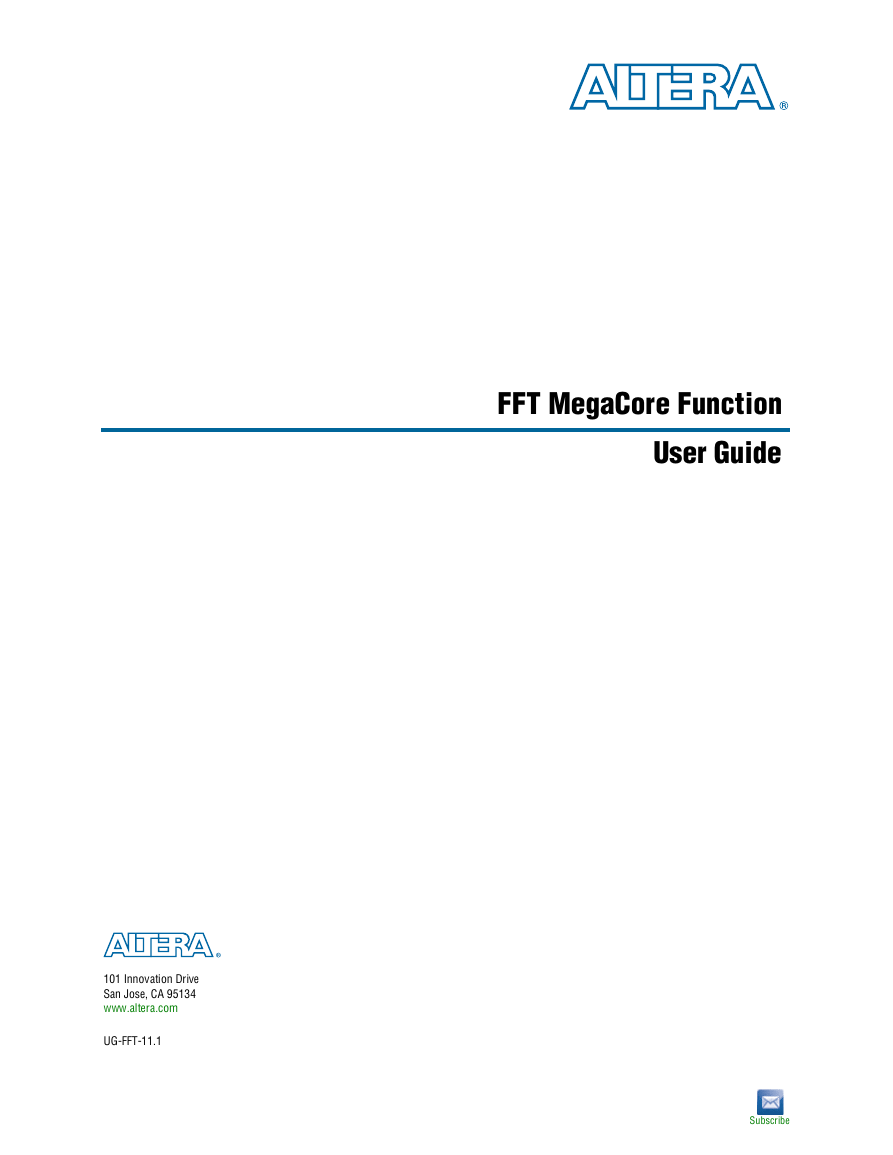

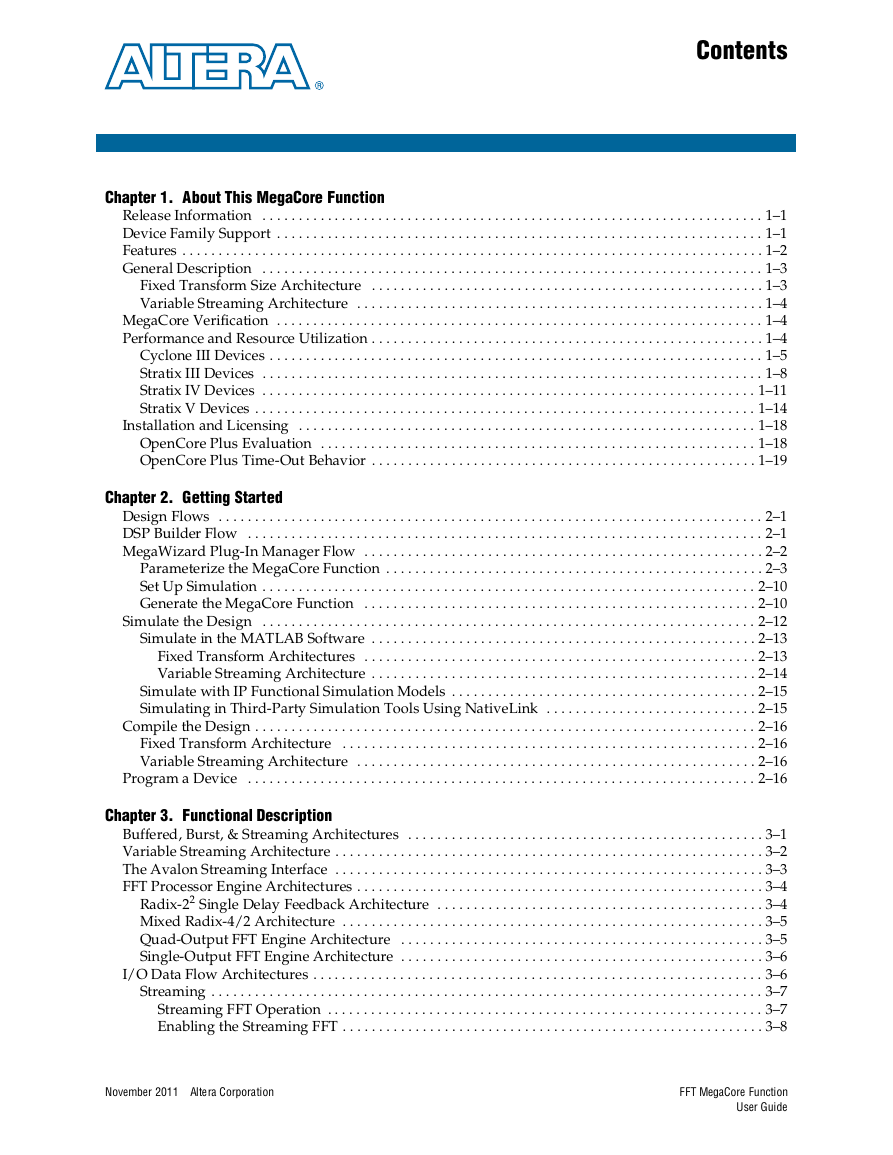
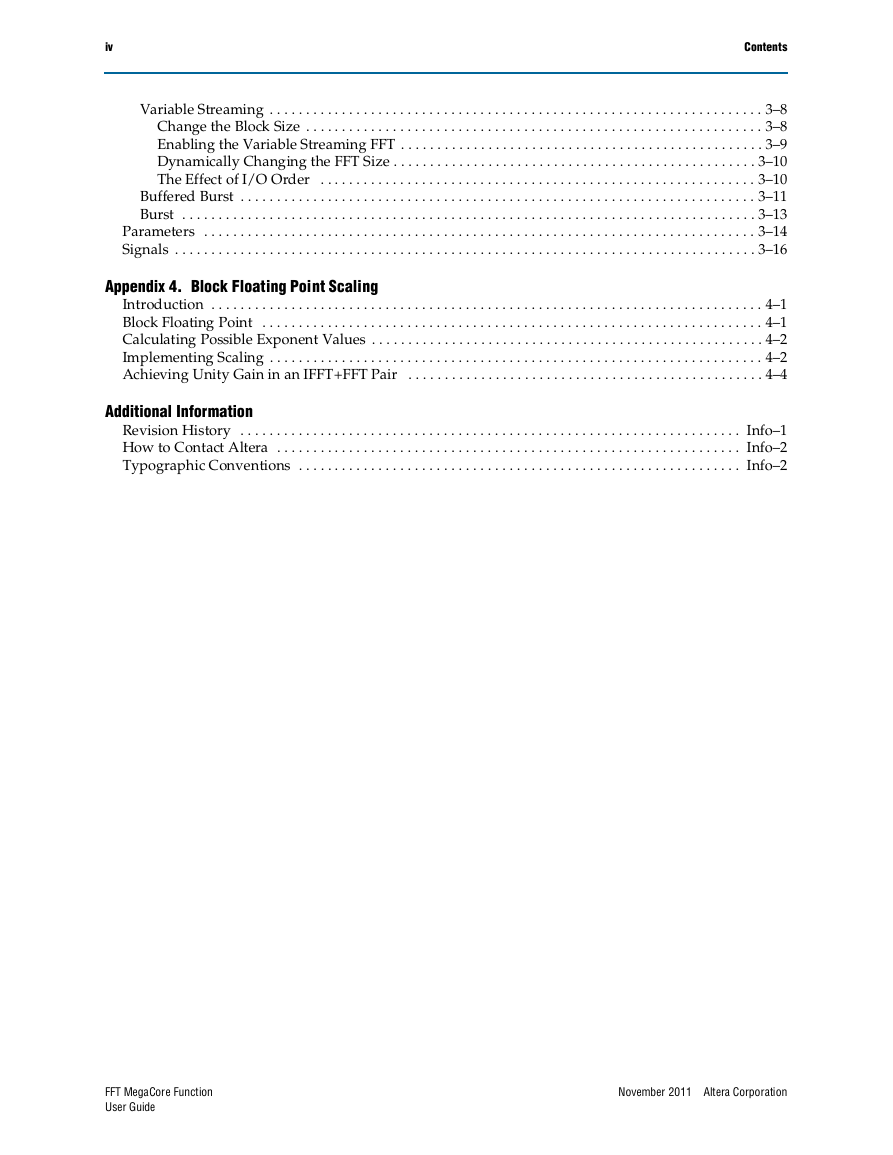
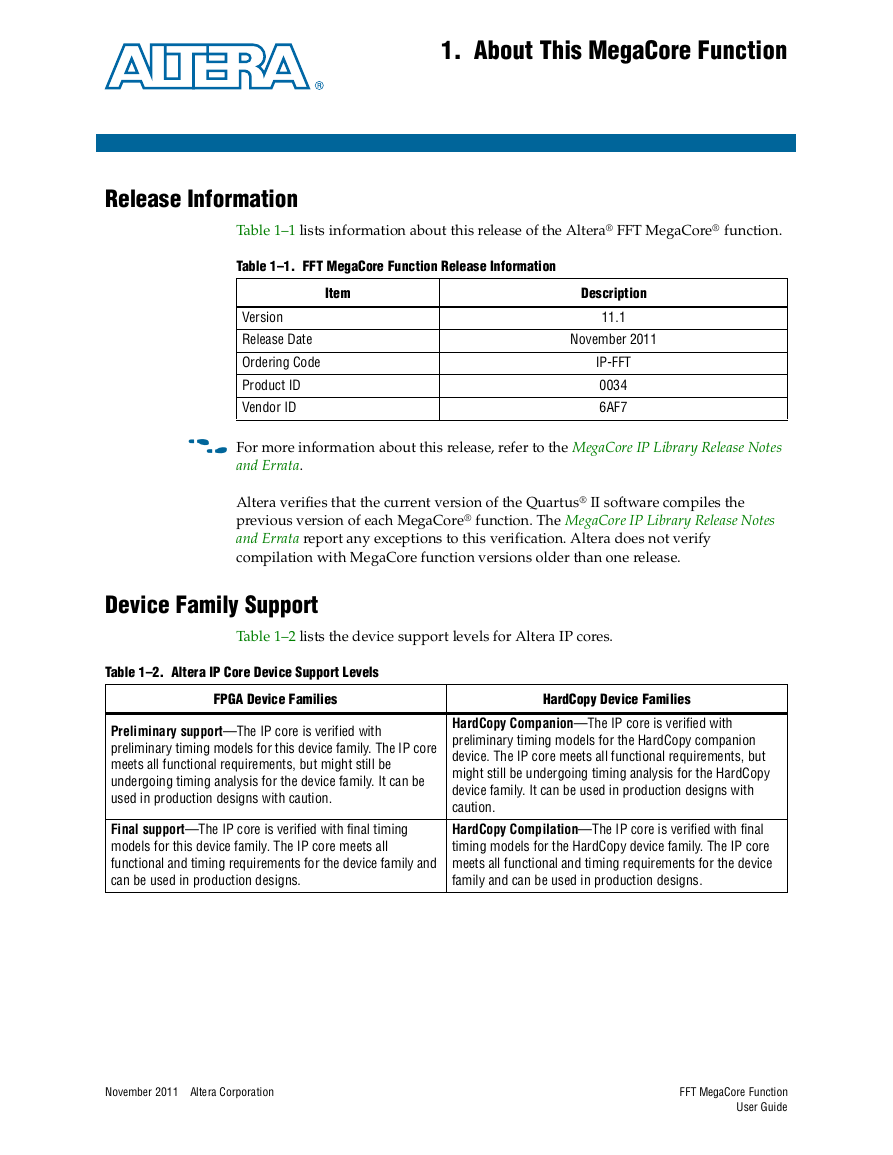
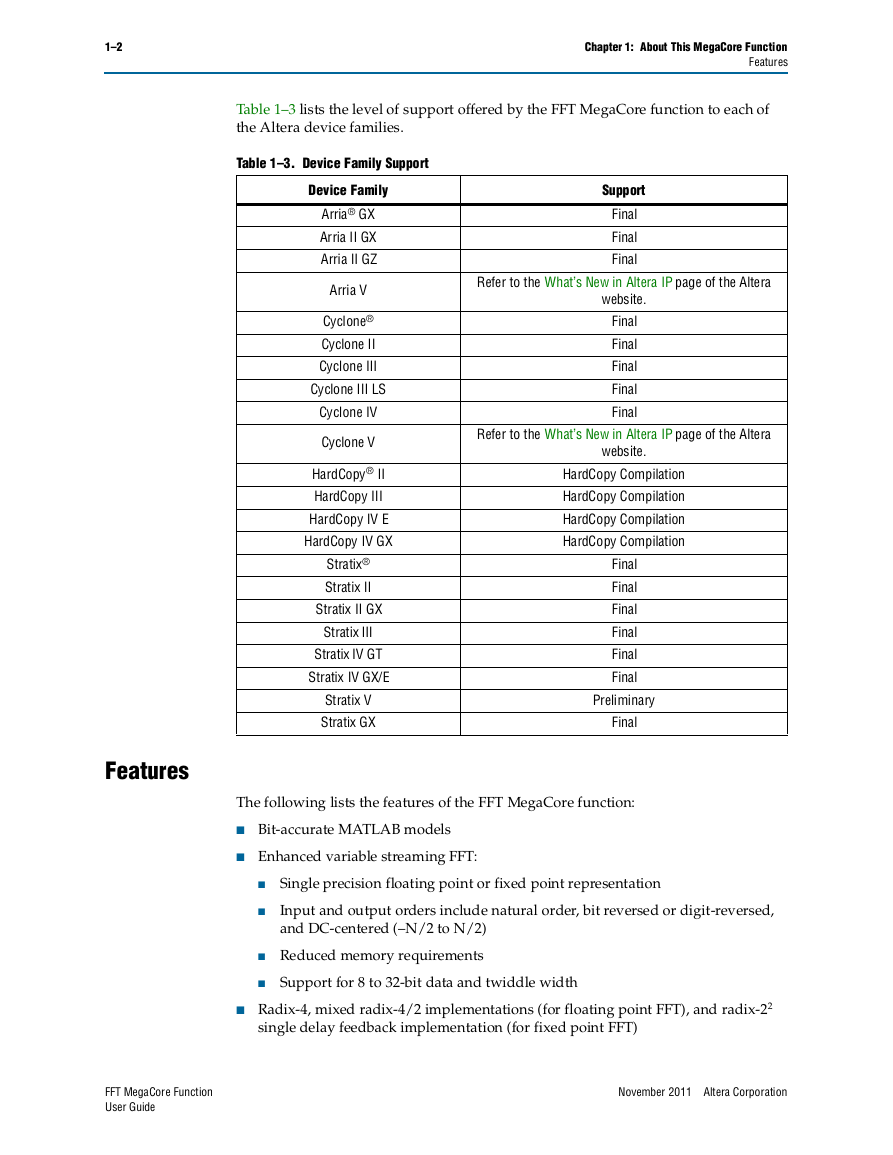
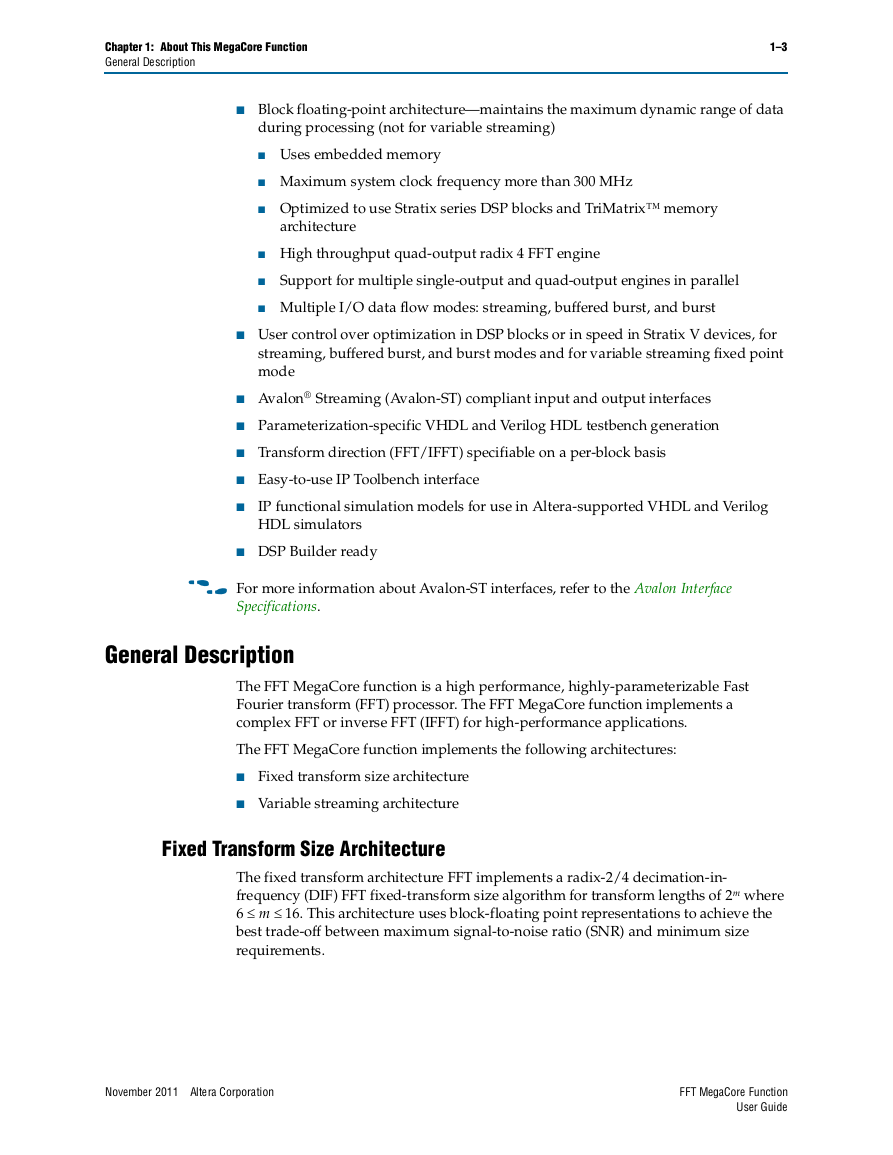
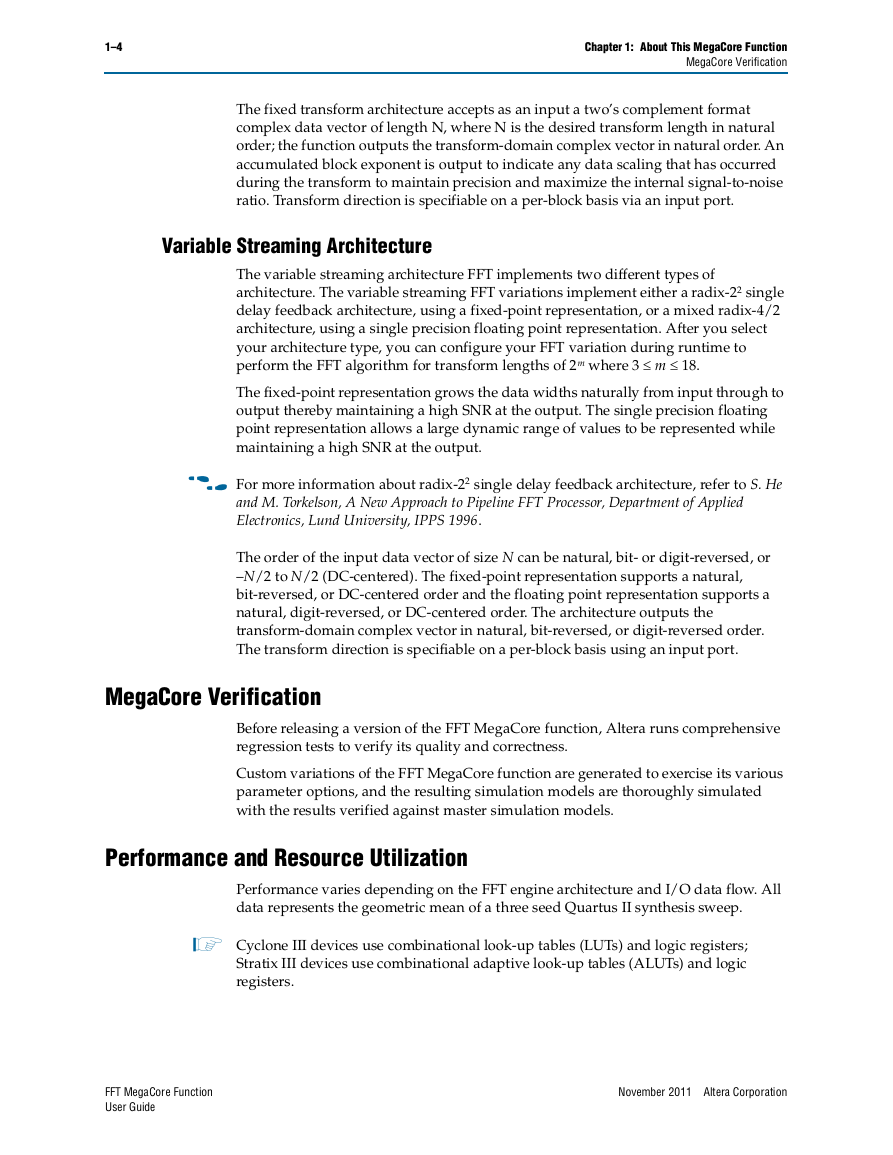








 2023年江西萍乡中考道德与法治真题及答案.doc
2023年江西萍乡中考道德与法治真题及答案.doc 2012年重庆南川中考生物真题及答案.doc
2012年重庆南川中考生物真题及答案.doc 2013年江西师范大学地理学综合及文艺理论基础考研真题.doc
2013年江西师范大学地理学综合及文艺理论基础考研真题.doc 2020年四川甘孜小升初语文真题及答案I卷.doc
2020年四川甘孜小升初语文真题及答案I卷.doc 2020年注册岩土工程师专业基础考试真题及答案.doc
2020年注册岩土工程师专业基础考试真题及答案.doc 2023-2024学年福建省厦门市九年级上学期数学月考试题及答案.doc
2023-2024学年福建省厦门市九年级上学期数学月考试题及答案.doc 2021-2022学年辽宁省沈阳市大东区九年级上学期语文期末试题及答案.doc
2021-2022学年辽宁省沈阳市大东区九年级上学期语文期末试题及答案.doc 2022-2023学年北京东城区初三第一学期物理期末试卷及答案.doc
2022-2023学年北京东城区初三第一学期物理期末试卷及答案.doc 2018上半年江西教师资格初中地理学科知识与教学能力真题及答案.doc
2018上半年江西教师资格初中地理学科知识与教学能力真题及答案.doc 2012年河北国家公务员申论考试真题及答案-省级.doc
2012年河北国家公务员申论考试真题及答案-省级.doc 2020-2021学年江苏省扬州市江都区邵樊片九年级上学期数学第一次质量检测试题及答案.doc
2020-2021学年江苏省扬州市江都区邵樊片九年级上学期数学第一次质量检测试题及答案.doc 2022下半年黑龙江教师资格证中学综合素质真题及答案.doc
2022下半年黑龙江教师资格证中学综合素质真题及答案.doc